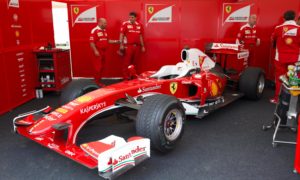Safety cars have about half the bhp of a Formula 1 car, and are about three times as heavy.
The safety car is an incredibly important part of a Grand Prix weekend. It allows Formula 1 races to continue with minimal disruption after major events and incidents where marshals are needed on the track. If marshals are on track, the race is obviously too dangerous to continue at full speed, even with yellow flags waving. In these instances, the safety car will be deployed and the pack will close up behind it in formation until the problem or obstacle has been removed.
The major problem with safety cars is that not even most of the fastest road-cars can keep up with a Formula 1 car. Even flat out, they will generally not be running at a fast enough pace to keep the Formula 1 cars entirely comfortable – Formula 1 cars are susceptible to losing tyre temperatures and overheating whilst running so slowly. Since 1996, Mercedes-Benz has supplied Formula 1 safety cars to all circuits. The current safety cars will be the CLK63 AMG. The cars themselves are not standard – they have modified engines, outputting approximately 481 bhp.
Even at the slower speeds, the driver of the safety car must obviously be very skilled. Since 2000, Bernd Maylander has piloted the safety car. He is an experienced racer, having raced in the German Touring Car championships, and mean that he can drive the car up to near it’s limits to ensure that the speeds are high enough for the Formula 1 cars to function properly.
When the safety car is deployed, if it joins the track at the front of the field, the orange lights on it will be activated. This signals no overtaking is allowed. If the safety car joins mid-field, and circumstances permit, the green lights will be left on until the leader approaches the safety car. The orange lights will then be activated. The purpose of this is to allow lower-running competitors to keep running so they are not stranded a lap down when the race restarts. A Safety Car board will be displayed to the drivers as soon as the safety car is on track. The drivers will also be told the safety car is out over their team radios. This ensures that they are aware that the safety car is on the track so that they can prepare themselves.
At the start of the safety car’s final lap, it will turn off it’s orange lights. All cars must still remain behind the safety car in formation, with no overtakng. The safety car will peel off into the pits at the end of the lap. As soon as the cars cross the start-finish line, they are racing again and overtaking is once again permitted.








